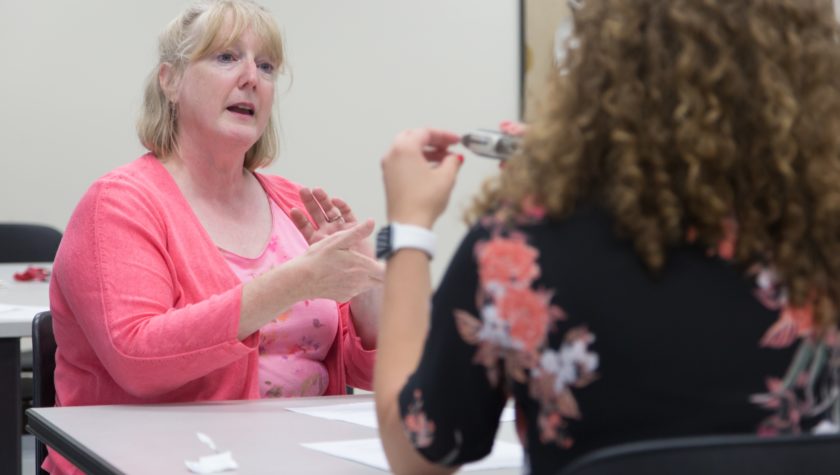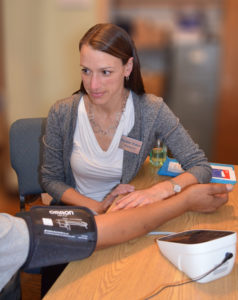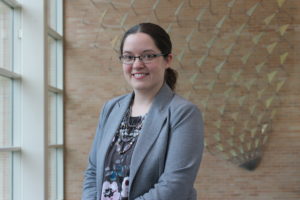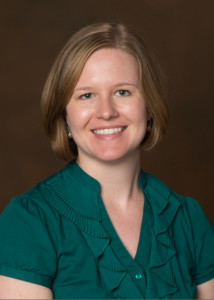
11
September

School of Pharmacy preceptors engage in professional development to improve student education and patient outcomes
By Katie Ginder-Vogel
“I needed to be able to document what students were doing in real time,” says Heather Walker, the managing pharmacist at Hometown Pharmacy in Waunakee.
Walker is one of the University of Wisconsin–Madison School of Pharmacy’s many preceptors who are tapping into new resources to enhance their precepting skills to advance both student learning and their practice as pharmacists.
In Walker’s case, she was hoping to develop a plan to complete student evaluations more efficiently and provide better, more useful feedback.
“I developed an observation form where I can list the student’s activities and the corresponding student performance category,” says Walker. “I used three modules from the preceptor development center—providing effective feedback, giving feedback, and the evaluation process.”

Walker wrote up her plan in November and immediately began using the forms she’d created.
“It worked like a dream,” she says. “I was able to watch students as they were working and make good notes, and then as I sat down to do the evaluation, I had all that information.”
With School of Pharmacy PharmD students spending their entire fourth year under the guidance of preceptors, the School’s preceptors play a prominent and critical role in shaping future pharmacists. This role is fundamental to students’ development into skilled, well-rounded practitioners, and the UW–Madison School of Pharmacy is investing in new ways to promote preceptor development to advance both student learning and pharmacy practice.
“The UW–Madison School of Pharmacy is known for being among the best for clinical training, and our commitment to preceptor development continues our tradition of excellence in training the strongest pharmacists to be better practitioners once they graduate,” says Mara Kieser, assistant dean of experiential education and professor in the Pharmacy Practice Division.
The School is helping preceptors continue their professional development in multiple ways. By helping preceptors hone communication skills and learn how to practice and reinforce key classroom content, such as interprofessional teamwork, the School of Pharmacy ensures that PharmD students have the best possible learning experience with preceptors.
Two initiatives work toward this goal. In early 2018, the UW–Madison Teaching Academy launched a new online learning community geared toward connecting School of Pharmacy, School of Nursing, and School of Medicine and Public Health “preceptors” (who go by different titles in different professions) to exchange best practices for mentoring future health care practitioners.
“The UW–Madison School of Pharmacy is known for being among the best for clinical training, and our commitment to preceptor development continues our tradition of excellence in training the strongest pharmacists to be better practitioners once they graduate.” –Mara Kieser
In addition, the School of Pharmacy’s Continuing Professional Development (CPD) program guides preceptors to create an individualized, self-driven learning plan that helps them improve specific skills by setting and meeting measurable goals for teaching improvement.
Walker, like many, created an improvement plan through the CPD program and worked toward her goals by using materials available from the School of Pharmacy.
Pooling interprofessional expertise
The aim of the UW–Madison Teaching Academy’s free online learning community for UW–Madison clinical faculty and preceptors is to reinforce clinical teaching and allow preceptors to learn from—and with—each other.
The Teaching Academy Fellows from the School of Pharmacy’s Pharmacy Practice Division include Associate Professor Casey Gallimore, Associate Professor and Associate Dean of Student and Academic Affairs Karen Kopacek, Professor and Assistant Dean for Assessment, Teaching and Learning Beth Martin; and Associate Professor Denise Walbrandt Pigarelli.

“The online learning community was developed by an interprofessional team that included all the clinical professional development instructors in health sciences at UW–Madison,” explains Assistant Professor and Experiential Learning Coordinator Amanda Margolis. “We all pooled our knowledge to create a repository with materials from Family Medicine, Nursing, Pharmacy, and Medicine and Public Health.”
In addition to the centralized resources, the online learning community offers numerous opportunities for preceptors from all health sciences disciplines to chat with each other online. Monthly prompts are posted to spark discussion, and occasionally preceptors can choose to join a book club that will look at health education issues.
“One topic, ‘Relentless Curiosity,’ was based on the Wisconsin Idea,” says Margolis. “And another, ‘Reflective Practice,’ asked preceptors how they build reflection into their students’ learning experiences.”
The Teaching Academy group is also working to create a series of online journal clubs related to precepting topics, with discussion questions that participants can answer at their own pace and use to interact with other participants over the course of a week.
Supporting top-notch clinical teaching
UW–Madison-affiliated preceptors and clinical teachers who dedicate their time and energy to the Teaching Academy, even though their main employment is outside the UW campus, can receive a clinical affiliate designation. Clinical affiliates are preceptors who, aside from their precepting duties, work outside of the UW and are recognized by the university as being outstanding clinical teachers or have used the Teaching Academy’s resources to enhance their clinical teaching.
“We want to give our School of Pharmacy preceptors recognition for going the extra mile to improve their teaching,” says Margolis. “It’s an opportunity for preceptors to learn new ideas and techniques for engaging students. If a preceptor enjoys precepting, engages in training, and gets recognition, it can make their instructional methods more exciting for students.”
Online curriculum for preceptors
The group is also developing the curriculum for a free online interprofessional teaching and learning program for UW clinical instructors in the health sciences.
“The School of Pharmacy had been planning to develop something similar internally, and then the opportunity arose to do so in conjunction with an interprofessional group,” explains Margolis.
“Stronger preceptors and more refined precepting create better learning experiences for students.” –Amanda Margolis
The School is committed to building interprofessional education into its PharmD program, and including differing perspectives in preceptor development presented the opportunity to enhance this experience. The new interprofessional preceptor training module will be hosted online to be accessible to UW preceptors around the state.
“We’re creating something new from our knowledge,” says Margolis. “Interprofessional team-based care is a huge part of pharmacy practice, and this training will help preceptors understand what students are learning and give them the techniques and tools to reinforce the Interprofessional Education Collaborative’s core competencies.
“As we build more training modules to disseminate new techniques to preceptors, we can measure how this changes preceptor behaviors and student training, plus its impact on patient care,” says Margolis.
Optimizing precepting through reflection
Created in conjunction with the Division of Pharmacy Professional Development, the free online Continuing Professional Development (CPD) program is open to all preceptors affiliated with the UW–Madison School of Pharmacy. Participating preceptors completed a half-hour online orientation, and then reviewed their student feedback.
Last year, participating preceptors completed a reflection on their own teaching skills and developed an actionable plan about what they wanted to improve.

Margolis shared resources on the qualities of award-winning preceptors and PharmD students’ feedback about the skills that top preceptors bring to their teaching. She then asked the participating preceptors to reflect on how, specifically, they wanted to improve.
Margolis created templates preceptors could use to draft their own development plans with measurable objectives, so they can track their own improvement. Many preceptors wanted to focus on giving students more effective feedback, while others wanted to work on organizing rotations, and yet others prioritized scheduling discussion times with their students.
One preceptor’s development goal was “I will use resources on giving feedback and improve the structure of constructive feedback I give students to more consistently share improvements.”
Of the School’s more than 1,400 preceptors, over a third completed the reflection and development plan stages of the CPD process during the 2017-2018 academic year, and 444 claimed continuing education credit for the program, which helps them maintain their licensing. Preceptors choose how to work on their objectives—watching videos, having discussions, and reading articles are a few options.
“My CPD plan was to work on personalizing teaching based on students needs and continue incorporating active observation into my daily precepting skills,” said preceptor Melissa Forbes (PharmD ’10), a clinical pharmacist at Gundersen Lutheran Medical Center in La Crosse, Wis. “I collaborated with my colleagues, utilized an article in JPSW [Journal of the Pharmacy Society of Wisconsin] on precepting processes, and looked at one of the preceptor development modules on learning styles from the UW-Madison School of Pharmacy preceptor development center website.”
“The next phase of our preceptor curriculum is closing the CPD loop and encouraging preceptors to come up with new precepting goals to continuously improve their precepting for our PharmD students,” explains Margolis.
Margolis presented a poster of data from preceptor self-evaluations at the American Association of Colleges of Pharmacy’s Pharmacy Education 2018 meeting. The poster traces preceptors’ future directions, what they’re working on now, and the topics on which they chose to focus, such as feedback.
“Stronger preceptors and more refined precepting create better learning experiences for students,” says Margolis.
Learn how to become a preceptor for the UW–Madison School of Pharmacy and get involved with the UW Teaching Academy.
Current preceptors can log into the School of Pharmacy clerkship site to access the online preceptor curriculum.




